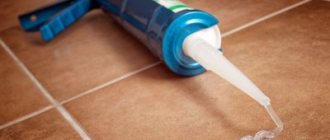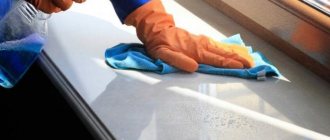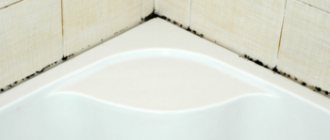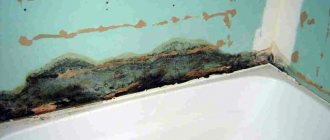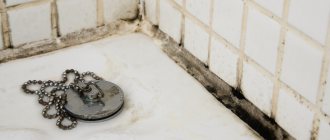To maintain the functionality of the mixer, it is necessary to properly care for it, as well as monitor the condition of the water in the pipes. Faucets are often covered with white spots, soap stains and other contaminants that negatively affect the operation and appearance of the devices. Therefore, it is useful for every housewife to know how to clean the faucet in the bathroom using improvised means.
You can easily clean your bathroom faucet from dirt at home.
Causes of pollution
Plaque formation on plumbing fixtures occurs when water is too hard, caused by a high concentration of mineral deposits. In most cases, main water pipes are contaminated with magnesium and calcium salts. When mixed with soapy water, they leave unpleasant streaks and marks. If the iron salt content is excessively high, it will lead to the appearance of a yellow precipitate.
However, deterioration in appearance is a visible sign of a problem. Limescale deposits can also accumulate on the inside of the faucet, where a small amount of water remains.
In particularly difficult cases, water stone appears on moving parts, which negatively affects the performance of the taps, and sometimes leads to their complete damage.
In this case, the intensity of the appearance of deposits is determined by the frequency of use of hot water. If its temperature exceeds 70°C, salts are deposited faster and form scale. This unpleasant phenomenon often occurs in boilers and washing machines, but is sometimes also typical for faucets. Therefore, it is important to clean the device inside and out on time.
Single lever mixer with ball switch
Alas, modern faucets, like their valves, fail from time to time. After all, their production uses the same materials: metal, rubber and plastic, which can wear out during operation or under the influence of external factors.
To repair a ball valve, you need to understand its structure and be able to dismantle it if necessary. The ball device includes:
- rotary handle; At its core, it is a lever, which is sometimes called a “butterfly”.
- stock; The rod seal is adjusted using a nut and washer, which are also included in the package.
- body with nut; The ball cartridge and rod are located inside this housing.
- ball cartridge; It is fixed using rubber saddles.
A ball cartridge is a non-separable element that has three holes: for incoming cold and hot water and for removing mixed water of the required temperature and pressure from the device.
The operating algorithm for a crane of this design is quite simple:
- when the lever is lifted, the ball begins to rotate;
- the holes on the ball cartridge begin to align with similar holes in the seats;
- Depending on the area of coincidence of these holes, the jet pressure changes.
General rules for cleaning faucets from limescale at home
Chrome coatings quickly deform under improper mechanical or chemical influences. To eliminate such troubles and prevent wear and tear of the product, you need to adhere to several rules:
Do not use to clean the mixer
hard sponges and chemicals.
- Do not use rough materials to clean chrome surfaces. It is better to avoid metal brushes, hard sponges and graters. If this recommendation is not taken into account, the chrome plating layer may become deformed and become scratched. Further oxidation and interaction with water will lead to the development of corrosion.
- It is prohibited to treat the mixer with abrasive compounds, chlorine-based preparations (“Belizna” or “Domestos”), as well as aggressive acids, including formic, oxalic, sulfuric, hydrochloric and phosphoric. Contact of the listed products with the faucet material causes the appearance of dark spots and blackheads, which are almost impossible to get rid of. The instructions for such compounds often mention their areas of application and the warning “Do not use for processing chrome coatings.”
- After removing dirt, the taps and mixer should be polished with a cloth. This will keep their shiny surface for a long time.
- Hard-to-reach sections can be cleaned using toothbrushes and bottle brushes.
- Traces of corrosion from chrome coatings are removed using aluminum foil dipped in liquid. The material quickly reacts with damaged surfaces and removes stubborn stains.
- When working with vinegar and household chemicals, ventilate your home. Otherwise, acid fumes and other volatile compounds can cause allergic reactions and irritation of the upper respiratory tract.
Plaque on the aerator and shower head
When cleaning the faucet, do not forget about the mesh filter at the end of the gander, which is called an aerator. It is designed to mix the flow of water with air to increase the volume of flow. This filter most often becomes clogged from debris that passes along with the water through the water pipes. The following phenomena may be a signal that the mesh is clogged:
- Weak or completely absent water flow when valves are open.
- Uneven and non-vertical water flow.
To clean the faucet mesh you need to do the following:
- Unscrew the nozzle using pliers, after wrapping it with a damp thin rag to avoid scratches and chips.
- Apply a rag soaked in vinegar to the nozzle if it does not come off.
- Rinse the filter under running tap.
- Soak the aerator in vinegar for several hours so that the mesh rods are completely cleared of plaque.
- Rinse the vinegar strainer in water and place it back on the faucet.
The shower head is cleaned in the same way, which should be disconnected from the hose, disassembled, cleaned of large debris and soaked in heated vinegar to completely remove plaque. After all this, all that remains is to assemble it in reverse order.
Traditional methods for cleaning faucets outside
You can clean a clogged bathroom faucet using proven folk remedies. These include:
- Vinegar.
- Toothpicks.
- Salt.
- Soda.
- Laundry and baby soap.
- Coca-Cola.
- Citric acid.
- Wiper.
- Microfiber cloth and other products.
Vinegar
Used after dilution with water in a 1:1 ratio. It is applied by spray or sponge and left for 30-60 minutes (taking into account the nature of the contamination). After this, the surface can be washed with clean liquid.
To quickly clean the faucet and remove deposits, you can use vinegar.
No less effective are vinegar compressors, which are suitable for treating surfaces with old plaque or hard-to-reach places. The cleaning principle involves wrapping the contaminated area with a cloth soaked in a solution. This compress is kept for 60 minutes and then washed off with water. Acetic fumes effectively corrode lime, so there is no need to additionally wipe the coating. But if the plaque does not disappear after treatment, it is better to repeat the action.
When working with vinegar, you should take precautions and avoid getting it on mucous membranes.
Toothpicks
You can remove limescale deposits on stainless steel faucets using a toothpick. This device is suitable for removing small stains on textured surfaces.
The toothpick is taken by both edges and pressed against the tap to remove plaque. Cooking nets have identical properties. With their help, you can clean even the most difficult to reach areas with small deposits.
Soda
The substance is applied to a soft brush (an old toothbrush will do) and then rubbed onto the sanitary ware. For ease of use, baking soda can be mixed with liquid to obtain a mushy consistency. After careful handling, the mixer should be rinsed under running water.
You can use baking soda to remove mineral deposits from your faucet.
Salt
Used to effectively remove long-standing stains and restore surface shine. However, the composition should not be distributed by rubbing movements, as this may lead to deformation of the coating. Instead, you should carefully apply salt to the faucet and then rinse with water.
Laundry soap
It is one of the cheapest and highest quality means for combating salt deposits on plumbing fixtures. To prepare the working mixture, you need to take a third of the soap and grate it on a coarse grater. Then the raw material should be diluted in hot water to obtain a creamy consistency.
Traces of plaque are wiped with a soft sponge soaked in the solution and left for 20-30 minutes. After this time, the surface is cleaned again and then washed with water. To enhance the effect, add 1-2 tbsp to the composition. l. soda
Baby oil
Baby oil is an unusual but proven solution to stains on taps. To get rid of plaque, you need to do the following:
- Soak a soft cloth in a bowl of baby oil.
- Wipe dirty areas with a cloth.
- Rinse the product with water to remove any remaining oil.
- Polish the faucet using flannel or chamois leather.
This method effectively removes soap stains, grease stains and salt deposits.
Baby oil will help remove the white residue that has formed on your plumbing fixtures.
Toothpaste
A toothbrush and toothpaste are the simplest tools for removing plaque from plumbing fixtures. But when choosing this method, you need to prepare a brush with soft bristles, since other types can damage the surface. Toothpaste is effective when processing materials with small relief.
Coca Cola
The sweet drink can be used to make a high-quality compress to remove dirt from plumbing fixtures. The plaque control process itself includes the following stages:
- The cloth should be soaked in the drink and then applied to the problem area.
- After 15-20 minutes, the product is washed with clean water and wiped dry with a dry cloth.
Due to the content of special acids, the product gives a quick effect.
Lemon acid
To remove salt deposits with citric acid, you need to do the following:
- Open the tap.
- Prepare a solution of citric acid and water, following the proportion: 4 tbsp. l. per 1 liter of liquid.
- Place the product in the container with the product and leave it for 1-2 hours.
- Remove the device and wash under running water.
- Wipe surfaces dry with a soft cloth.
Citric acid effectively removes plaque on chrome surfaces.
Also suitable for processing is a clean lemon, which is cut into 2 parts and used to wipe dirty surfaces. A small portion of the juice can be squeezed into a glass for later use in the kitchen.
After completing the processing, wipe the unit with a dry cloth in order to get rid of unnecessary stains.
This folk method provides a quick fight against contaminants and removes them in a few minutes.
Glass cleaner
There are different window cleaners available in the market. But they are also suitable for removing plaque from bathroom faucets. To eliminate unnecessary marks, just apply the liquid to the problem area and then wipe with a soft cloth.
Microfiber cloth
Microfiber cloths have appeared on sale relatively recently. However, they have gained popularity due to their effective cleaning of various surfaces, including faucets.
Prevention of plaque formation
Even old plaque will not be able to resist household or store products. But the faucets have a complex shape and are very inconvenient to clean. To ensure that such headaches occur as rarely as possible, listen to some tips:
- Clean your faucet often, don’t wait for dirt to accumulate.
- Perform preventative cleaning by disassembling the faucet and cleaning all internal elements.
- Apply a moisture-proof coating. On sale you can find compositions that not only clean the surface, but also protect it from moisture. But they are difficult to find, and compositions from professional series are expensive. You can cover the surface with cosmetic oil or regular vegetable oil. Treat the surface with a sponge on which oil has been applied, and then polish with a napkin. This will not prevent plaque from forming, but it will be much easier to remove. Water does not linger on the oil and flows off, so there won’t be much of a deposit.
- Use wax polish. Chrome-plated parts of cars are often treated with such compounds. Not the best option, but there are benefits. The main thing is to make sure that the composition is safe.
- Install a main filter to make the water softer. You can find a variety of options for such devices, which differ not only in design, but also in cost, as well as efficiency. The most effective are ion exchange and reverse osmosis devices.
Eliminating the cause of its occurrence will solve the problem of plaque once and for all. Don't wait until stubborn limescale stains appear. Wipe down the faucet after each use. If it is possible to install a water filter, install it. With this attitude, taps and mixers will always be shiny and will do their job properly.
Subscribe to our Social networks
Proven Industrial Products
If folk remedies are not able to remove plaque, you should purchase household chemicals. Its disadvantage is its negative effect on the skin. Therefore, before handling the faucet, you need to provide personal protective equipment such as a face mask and gloves.
Some drugs cause allergies and other side effects.
To quickly get rid of contaminants, it is recommended to combine 2 types of industrial products:
- Polishes.
- Cleaners.
Housewives speak positively about household chemicals from the following companies:
- Top House. The German brand produces compounds for treating stainless steel structures.
- Cif. A company from Hungary that produces high-quality plumbing care products.
- Cillit Bang. A Russian company that produces chemicals to remove plaque on metal.
Cillit Bang is a powerful solution for removing plaque and dirt.
Effective chemicals
To clean the faucet from limescale, it is necessary to use products to protect the skin and respiratory tract.
You should wear rubber gloves and a face mask to avoid harm to your health. There are many preparations for cleaning steel and chrome surfaces. But they all have only two varieties: cleaners get rid of dirt and deposits; polishes are used to bring the product to its original shine. Ideally, it is better to immediately purchase both products at the same time.
To clean the mixer, do not use abrasive tools or products to avoid damaging the coating.
The use of abrasives will cause scratches on the shiny surface. Choosing the wrong drug will definitely lead to microscopic damage. These, in turn, will cause rust. Further darkening of chrome parts is also a consequence of the wrong choice of chemistry.
In the fight against limescale, you should not use products that contain chlorine, alkalis, hydrochloric or phosphoric acid. There are special safe liquids and gels on sale created for cleaning chrome parts: for example, “Cilit” or “Cif” from a Hungarian manufacturer. Among the domestic products, “Selena Shine of Steel” is very popular.
Instructions are printed on each bottle. You need to follow it when cleaning the bathroom. Under no circumstances should you try to scrape off plaque with sharp objects or a wire brush. This will cause the surface of the mixer to become cloudy and dark areas will appear on it, which will then be impossible to remove.
Instructions for disassembling and cleaning the inside of the mixer
If the faucet often clogs, it needs to be disassembled and cleaned inside. Before you begin dismantling the unit, you should determine its type. The following options are available for sale:
- With 2 valves and valve axle boxes.
- With cartridge and 1 lever.
- Ball models.
Double valve design
To disassemble a mixer with 2 valves, you must:
- Shut off the water supply. A locking mechanism is installed in the bathroom or toilet.
- Remove the assembly. To do this, you need to unscrew the nuts securing the housing to the eccentrics. At this stage it is important to be careful not to damage the nuts.
- Get rid of the plugs on the valves. Below them is a screw that will need to be loosened to remove the valve.
- Unscrew the valve axle and remove it from its seat. Actions with the second valve are carried out according to a similar scheme.
- Remove the gooseneck from the mixer. To do this, you need to unscrew the union nut.
Disassembling a two-valve type mixer.
After disassembling, the parts need to be cleaned by first removing all the gaskets. This is a mandatory action, especially when caring for old crane axle boxes. It is important to assess the condition of the gasket and, if necessary, replace it with a new one.
With one lever
To disassemble a mixer with 1 lever you need:
- Shut off the water supply.
- Unscrew the fixing screw.
- Remove the handle from the cartridge rod.
- Unscrew the skirt holding the cartridge and unscrew the nut.
- Take out the cartridge.
The gaskets are located on the bottom of the cartridge. If they are out of order, it is better to change them.
Ball
Ball mixers are modern plumbing products and are in demand due to their ease of use. Such units rarely leak and maintain economical water consumption.
Since the faucet comes with one adjustment knob secured with a screw under the cover, the dismantling process does not take much time.
First you need to remove the faucet handle by loosening the screw that holds it in place. Next, press the notch of the threaded ring and carefully turn the ring counterclockwise. Then you need to remove the chrome dome and take out a plastic structure that resembles a shield. Traces of dirt can be removed with any folk remedy or household chemicals.
What you need to pay attention to when choosing a valve head
If you use faucets at home made in Russia or even in the USSR, then their rotating mechanism is equipped with a connecting part that has a square shape. Until now, this connection option is considered the most successful and reliable. It practically eliminates the possibility of erasing the edges and turning the flywheel. Devices manufactured abroad are more susceptible to this.
Crane axlebox options Source gilevasvetlana.ru
Such devices use a splined valve mount. There are many small grooves on the stem. When cut, it resembles an asterisk. The splines can wear out over time, and the product has to be completely replaced.
Restoration of damaged coating
If the surface of the faucet has been damaged or darkened, you will need to take steps to restore it. To solve the problem yourself, it is enough to treat the product with GOI paste, which hides dark spots. Before cleaning, the surface is wiped with machine oil and polished until the shine is restored.
GOI paste will help remove minor scratches and dirt from the surface of the faucet.
Technique for restoring shut-off valve functionality
When planning to restore the functionality of a ball valve, you should ensure not only the availability of the necessary tools, but also good lighting.
When restoring the operation of the faucet, you should first unscrew the self-locking nut (in some cases you should simply unscrew the screw that holds the rotary handle). All this can be easily done using a size 8 or 10 spanner wrench, and an open-end wrench also helps in this matter (everything initially depends on the crane model).
Next, you need to carefully remove the faucet handle. This, as a rule, is not easy, only after its gradual rocking, accomplished by alternating pressure on one or the other side of the structure. In this case, it is important not to knock on it - this will lead to the integrity of the flags and their breakage.
Now you should select the most suitable key, and then try to turn it, alternately changing the direction: first you can try to do it clockwise, and then counterclockwise. When carrying out the described actions, it is important to monitor their amplitude - it should be low, because with great effort there is always a risk of breaking the rod or tearing off the edges.
As soon as movement is noticed, the amplitude of the movements and their scope can be increased. When performing this work, it is very important to ensure that one of your hands holds the head on the rod, and the other turns it.
As soon as the rod moves as freely as possible, at this point you can put on the handle, and then secure it with a screw (or nut). Now you should continue the rocking process until the water supply is completely blocked.
Process considerations for precious metal taps
If the faucet is made of copper, brass, bronze or other noble metals, it is cleaned with special household chemicals. Brass products are treated with a cloth soaked in a soap composition or solution based on citric acid, vinegar and salt.
Copper is treated with salt and citric acid. Bronze parts are susceptible to staining. To eliminate the problem, it is enough to regularly care for the device with water and chicory powder. The remaining metals are cleaned with tomato paste, which is applied to the problem area for 30 minutes.
What is needed to replace it yourself?
Often homeowners hire professional craftsmen to replace or maintain plumbing equipment, since they themselves do not have the appropriate qualifications. However, routine operations such as replacing seals in faucets can easily be done by yourself. To do this you will need the following tool:
- Plumber's adjustable wrench.
- Screwdriver.
- Wrench.
- Pliers.
- Fum tape, sealant or rubber gasket.
- New parts that need to be replaced.
- A clean rag that can quickly absorb water.
The main thing to remember is that all plumbing operations are performed only after the hot and cold water supply to the underwater pipes has been completely shut off. In addition, there is a high risk of scratching the devices with a tool, so professional craftsmen wrap their ends with electrical tape.
Prices for faucet axles for mixers on the Russian market
Prices on Russian shelves for such products vary - it all depends on the manufacturer. The most popular are faucet axle boxes for Vidima mixers. But cheap Chinese products do not lose demand either. Let's look at several options with some characteristics and costs, as of April 2018.
| Marking, model | Manufacturer country | Max temperature, ˚С | Max pressure, bar | Average cost (as of April 2022), rub. |
| China | 90 | 12 | 95 |
| China | 90 | 12 | 81 |
| Russia | 75 | 12 | 480 |
| China | 90 | 1,5 | 159 |
These are products in a low price range. If we take the German one, then the cost of fittings of this brand reaches 4000 rubles.
Basic mistakes
There are several main mistakes that people make when they try to clean their taps of various contaminants.
Using a metal brush
Some people like to use hard metal sponges to remove plaque. But keep in mind that in fact it is better not to use them, as this will leave scratches and other mechanical damage on the surface of the faucet. For this reason, it is better to rub a surface contaminated with plaque with something else that is less traumatic.
Using bad detergent
Before cleaning, you should choose the right products, as some of them cannot be used either.
Abrasive particles
Sometimes it happens that detergent compositions contain abrasive particles, which can also harm the surface of the faucet when used. For this reason, we advise you to carefully study the composition of each product you plan to buy. If the composition contains a lot of abrasive components, it is better to avoid using such a product.
Acids
Some people who like to clean with the strongest compounds believe that it is best to use products with acids. But keep in mind that such compositions are not suitable for coating faucets and will even harm them.
For this reason, liquids containing the following acids cannot be used to clean contaminants:
- Sulfuric.
- Phosphoric.
- Solyanaya.
If you use them, the surface will eventually begin to become covered with dark-colored dots that cannot be washed off.
A mixture of several products into one
Some people even prefer to mix several detergents, believing that the resulting composition will ideally cope with the removal of limescale. But sometimes the result is so unexpected that you have to change the faucet altogether. For this reason, it is better to abandon such ideas and use other, more gentle methods, which are described below.
